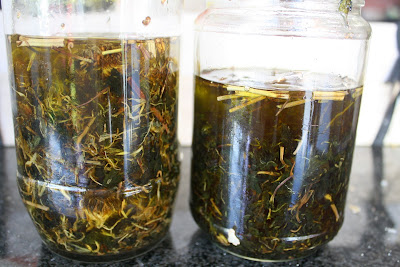Shampoo making technology is the same as soap making. But there are few extra steps and add-ons, recipe formulation is also different - no "hair heavy" oils, extra conditioning, hair therapy, and so on.. Here are some of the steps of shampoo-making process:
1. Herbal oil infusion
Herbal infusion takes time and patience - mixing oils with herbs, gently heating and stirring them for hours. This step starts before the actual shampoo-making.
left - sweet almond oil infused with camomile and sage, right - coconut oil infused with peppermint.
Herbs and plants are known for their healing and therapeutic qualities. And oil infusion is a wonderful way to transfer those properties onto the oils used in soap/shampoo making! Infused oils also make great massage oils (for example camomile infused sweet almond oil is excellent for babies) and additions to the other natural beauty products
Look at the picture above - transparent liquid is coconut oil, green liquid next to it is the same coconut oil infused with peppermint! Can you imagine how much of the herbal goodness there is in that one!
2. Preparing strong herbal tea and adding silk
No, tea is not for drinking while working :) To mix it with the oils later on. This one includes peppermint, sage and calendula.
I also dissolve Tussah Silk into the tea, see some silk fibers lying next to the herbal tea jar?
By the way, Tussah is humane wild silk, it is gathered after the moth emerges from the cocoon.
3. Next step is to measure the oils
This shampoo is made of coconut, castor, grapeseed, safflower, sunflower, sweet almond and soy oils! What a great combination, I tell you :)
8. The next day
I still need to trim the edges later on. Now shampoo is curing, hardening and absorbing the qualities of those wonderful ingredients that were put in. Process takes at least 4 weeks and then - ready to be used and enjoyed!
That's pretty much it :) Hope you had fun!
4. Pouring herbal tea mixture into the oils
5. Mixing all together
6. Adding essential oils (love that part!) - here we have peppermint, rosemary and lavender.
7. Pouring into the mold
Pictured freshly poured shampoo (btw - it's the first time I am doing shampoo in this mold)8. The next day
9. Cut, raw look
I still need to trim the edges later on. Now shampoo is curing, hardening and absorbing the qualities of those wonderful ingredients that were put in. Process takes at least 4 weeks and then - ready to be used and enjoyed!
That's pretty much it :) Hope you had fun!











Anya - I've been waiting for this post, just to see what goes into solid shampoos. As you know - I've been a big fan for long and started out with Lush's but because they still use SLS, have stopped using their product. However - I have yet to find a solid shampoo I like as much as theirs. All the others leave my hair matted and feeling like I have been swimming in chlorine. I've gone back to using liquid shampoo that is SLS/paraben free because it works better on my hair. I love the look of yours and wonder - how does it treat your hair? Do you notice a big difference in its results on your hair and other shampoos? When I am looking into buying from local soap makers, what should I ask them about their solid shampoos to see if I am getting a good product? Is it the silk? or the oil they use?
ReplyDeleteHey Brenda! Good question! There are two things to keep in mind - one is what washes your hair and second - what takes care of it. What washes your hair is a combination of oils, even though it's quite individual (as a start check with the seller what she recommends for your hair), but in general - watch out for "hair heavy" oils that can make your hair react the way you mentioned - mainly olive oil and palm oil (although i should mention that for some these two can work well). Typical shampoo oils are be coconut, castor, sweet almond, sesame, soy, safflower, grapeseed (those with the "lighter" texture).
ReplyDeleteThen the second part - it's the most fun :) Silk, herbal infusions, essential oils - all are there to take care of specific hair and scalp conditions. I also like to add a little bit of citric acid into my shampoos - it balances out the ph and works as a conditioner, but it's not an absolute must. Natural solid shampoo producers also recommend using apple cyder vinegar rinse (which works for me, btw). Is your hair dry or oily?
My hair feels softer, healthier and much easier to brush these days! I do oil mask once a week or so (warm up some oils+few drops of eo, clays or whatever else I have on hand - which is a lot of things in my case :)))).
And one more thing - I get "can't get used to it" comments once in a while - usually suggest to keep trying, because it can take time to adjust, so don't decide straight away after your first or even second wash..